August 15, 2012
Cabrillo 2012
The blog has been woefully neglected for the past few months as I’ve worked on a new sax quartet (“Unquiet Spirits,” for the Zzyzx Quartet, who premiered the first movement at the World Saxophone Congress in Scotland in July) and a new piece for the UNCG Wind Ensemble’s upcoming performance at the 2013 CBDNA conference. I also revised the score and parts for “Harvest: Concerto for Trombone,” for its performance at the Cabrillo Festival of Contemporary Music. And that brings us to today’s post. (Back in April, I blogged about how this performance came about.)
The festival ran for three weeks, and my performances were during the final week, with the first rehearsal on Wednesday night, and the final concert on Sunday night, meaning roughly a solid week away from home. We found a cat/house sitter (thank you, Peter!), put out Loki’s cans of wet food for the week, and were on our way to San Francisco.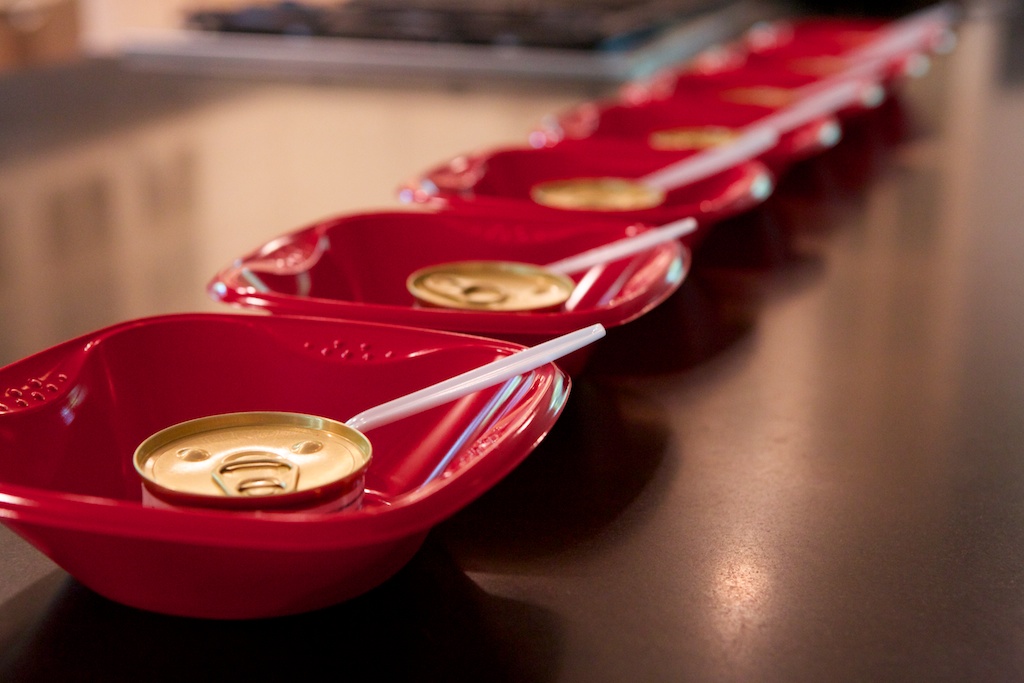
We flew on Virgin America, and it was a very pleasant flying experience (except when they wouldn’t let me use the restroom in first class, even though there were only four passengers in all of first class, and the bathroom was vacant; I almost attempted mutiny, but instead bitched about it on Twitter, which has become the most effective form of protest in contemporary society).
We lived in Los Angeles for three years, and I’ve been to northern California before (read about my residency at Cabrillo in 2005 if you haven’t), but this was my first visit to San Francisco. We stayed in the SoMa neighborhood. We were only there one night (heading to Santa Cruz for the festival the next day), so we went a little nuts on our hotel. (Gotta spend money to make money, I always say, but I’m not sure I completely understand what that expression means. I’m not your best source for financial advice.)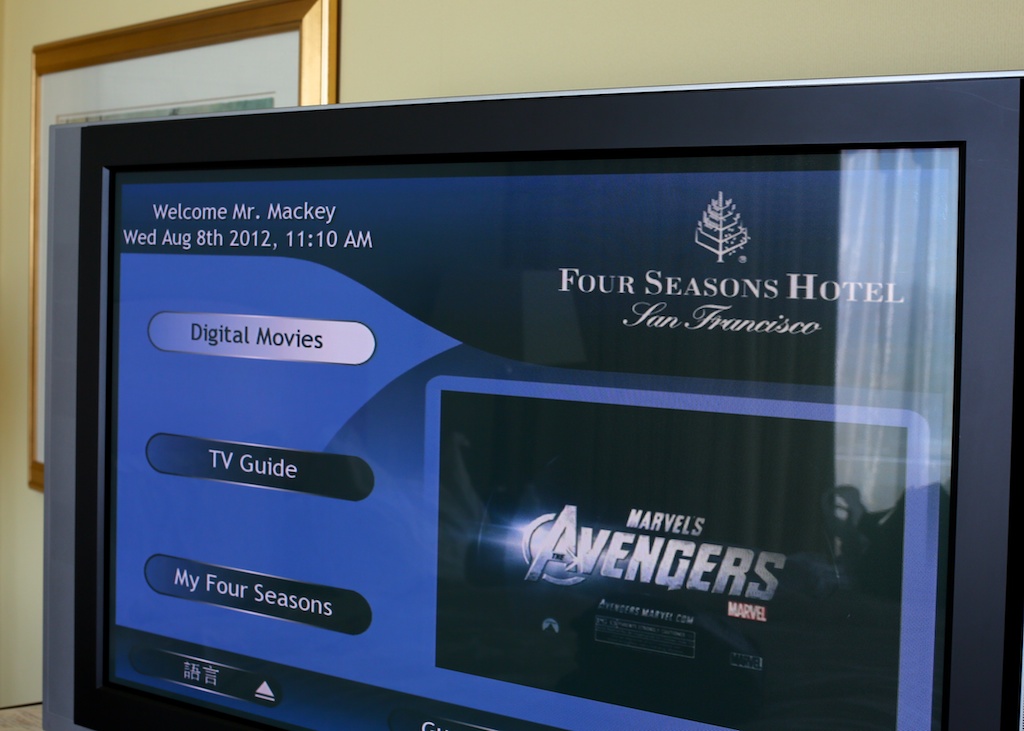
The view from our room was very nice. In the distance, you can see the bay. In the near distance on the right, you can see the Moscone Center, site of Apple’s WWDC events. (You could almost smell the iPhones.)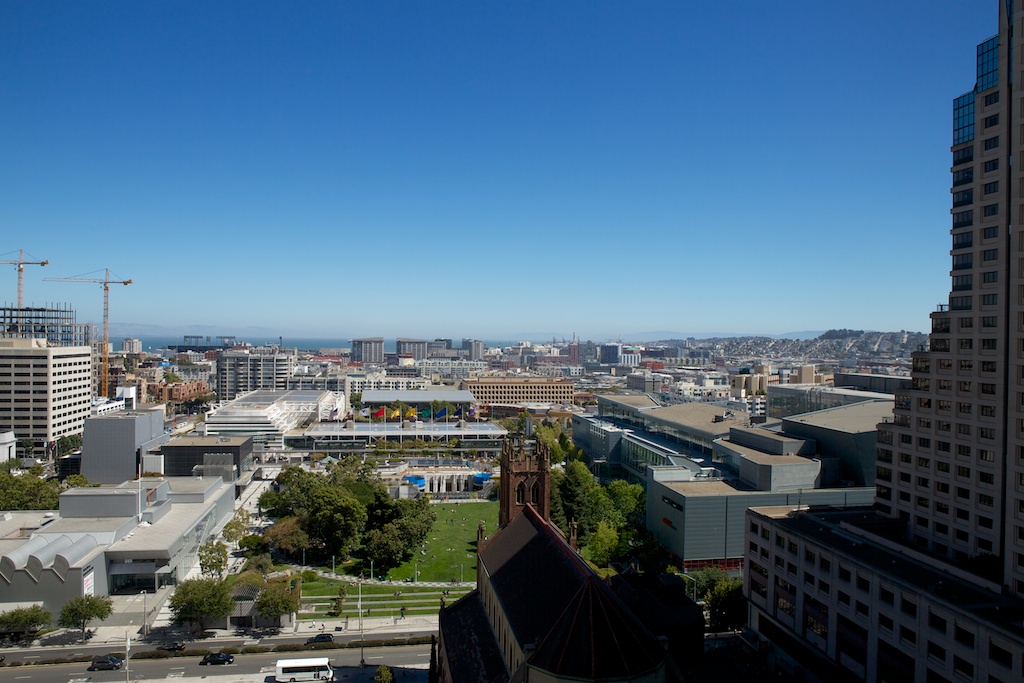
That night, we went to a restaurant called Coi for dinner. That will get its own (large) blog post soon.
Wednesday morning: room service breakfast!
For lunch on Wednesday, we went to Chez Panisse, Alice Waters’ legendary restaurant in Berkeley, known for originating that whole “organic farm-to-table, simple preparation” thing. My French isn’t so good, but I think “chez panisse” means “very yummy fun time,” or something like that. (Actually, it does not mean that.)
The lunch was delicious, but one thing about “simple presentation” is that it doesn’t look like much.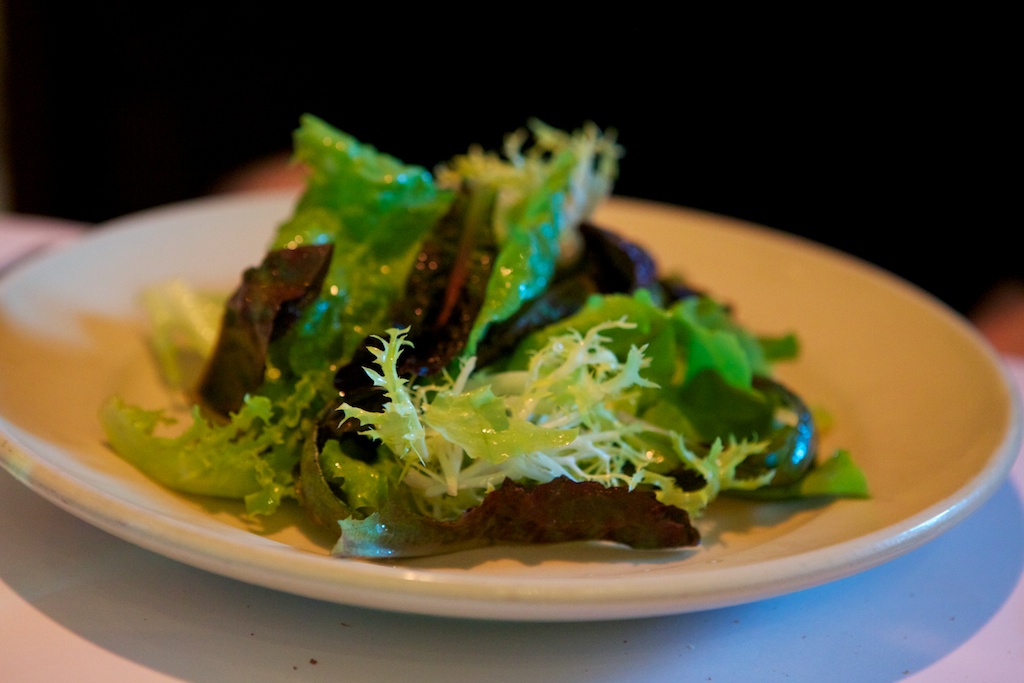
Finally, it was time to drive down to Santa Cruz for that evening’s rehearsal. This was the 50th Anniversary of the festival, and Marin Alsop‘s 21st season as the festival’s Music Director. Marin’s full-time job is as Music Director of the Baltimore Symphony, and she conducts several international orchestras as well. (She also speaks 12 languages, runs a successful Ethiopian restaurant, served as the officiant at John Corigliano & Mark Adamo’s wedding, and was briefly the mayor of Paris, Texas, but I may have dreamt at least some of those “facts.”) In other words, Marin is busy – and brilliant. The soloist on “Harvest” was Joseph Alessi, principal trombone in the New York Philharmonic, for whom I wrote the piece. (I’ve blogged about Alessi a bunch in the past.) The festival orchestra is wonderful, with players pulled from all over the country (the Atlanta Symphony, the Baltimore Symphony, eighth blackbird, and on and on), and the musicians are there because they love playing new music. This was going to be great. But first: a staring contest.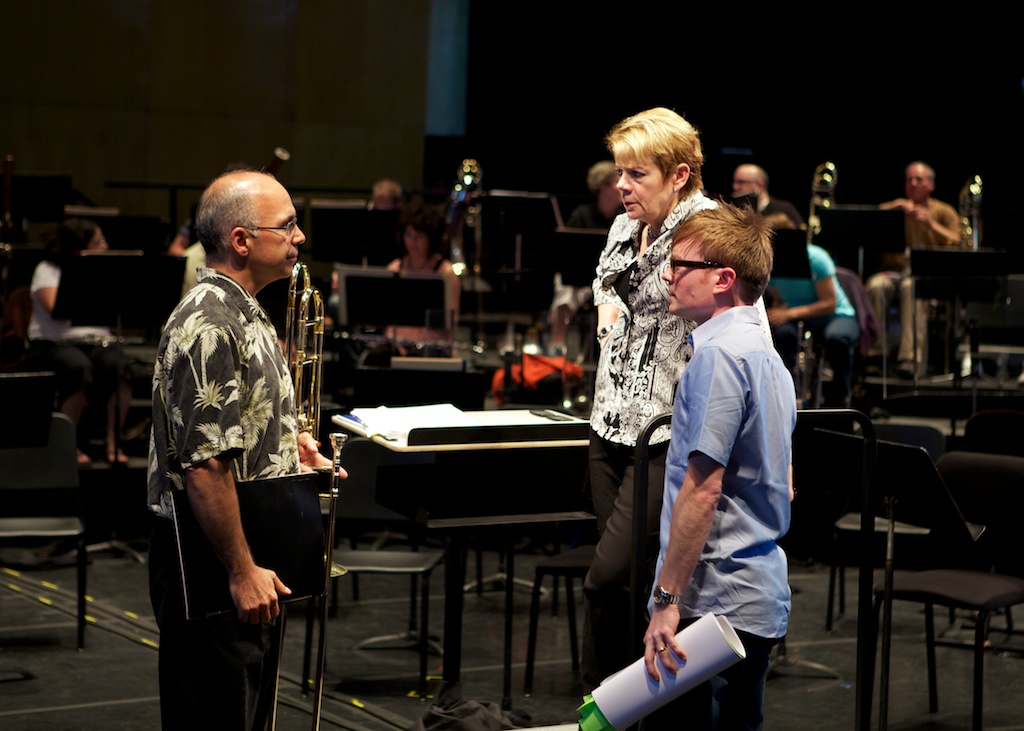
(Marin won.)
The first rehearsal was pretty amazing, considering this was the first time the orchestra had ever played the piece. As I told Joe after, “it was rockin’.” (Or maybe I was saying, “Hook ’em, Horns.”)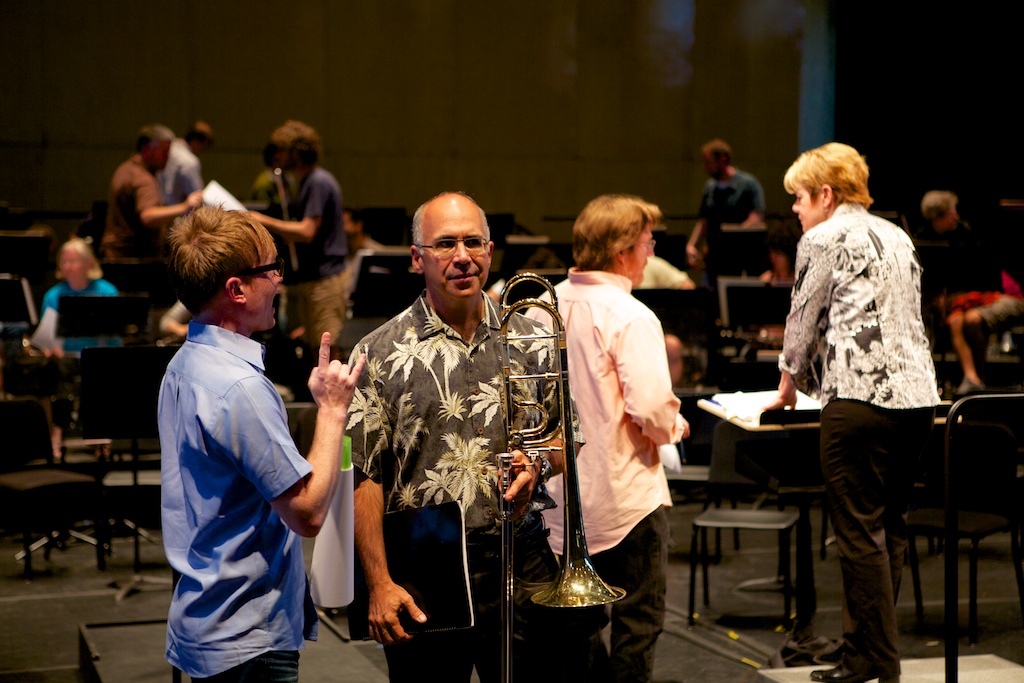
I’d revised the piece a little for this performance — changing the trumpets from Bb horns to C (the orchestral standard), adding some dynamics that helped with clarity throughout, and adding cues as landmarks during rests. That’s one big difference between band and orchestral cues — in band music, the cues are sometimes played. For example, you might write an English horn solo, but “cue” it in another instrument, like xylophone (because you’re an idiot), and if there’s no English horn in that group, or the player just isn’t somebody who should be playing a solo, then the cued part gets played instead. In orchestra, that does not happen, because the assumption is that everybody can play every part they receive, and a piece will have the requested instrumentation so substitutions won’t be necessary. In the case of orchestra, the cues are in the parts to show the players what’s happening during long spans of rests, so they know where they are, and come back in correctly. (The other difference is that bands have lots of rehearsal time and players figure out where to come in after long spans of rests, but in professional orchestra, there is much less rehearsal time, and they’re expected to play it basically right the first time they read it, so they need those cues so they don’t miss an entrance on that first reading.) Anyway, I added a bunch of cues to the parts. In one case, in a percussion part, a 5-bar multi-measure rest became 4 bars of multi-measure rest followed by 1 bar of cue from another instrument. When Finale formatted the part, though, it replaced the 5-bar rest with the 1 bar of music — and dropped the remaining 4 bars of rest. This caused some… confusion in the rehearsal. Sometimes I hate you, Finale. It only took 15 seconds of rehearsal time to figure out what happened, and it was easily fixed, but it was still embarrassing. The percussion section (who kick ass, by the way) was very nice about it.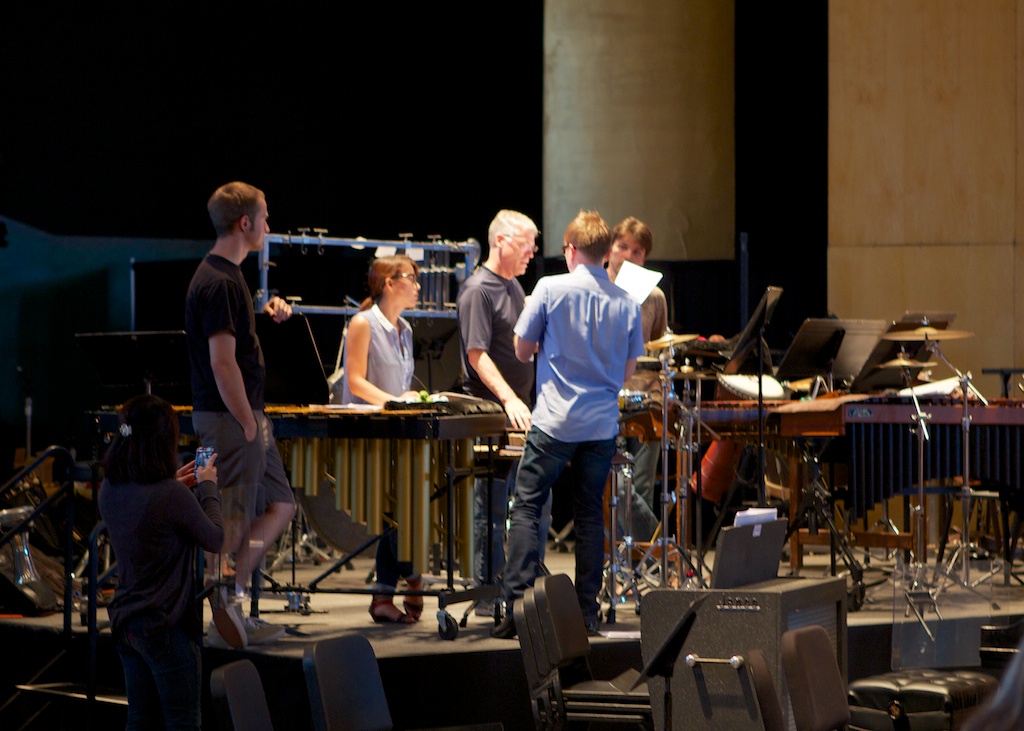
Thursday night was the Music in the Mountains concert — a fundraiser with wine and hors d’oeuvres from area restaurants and wineries. The venue, Nestldown, was like a hobbit village with human and animal topiaries…
… this elf house…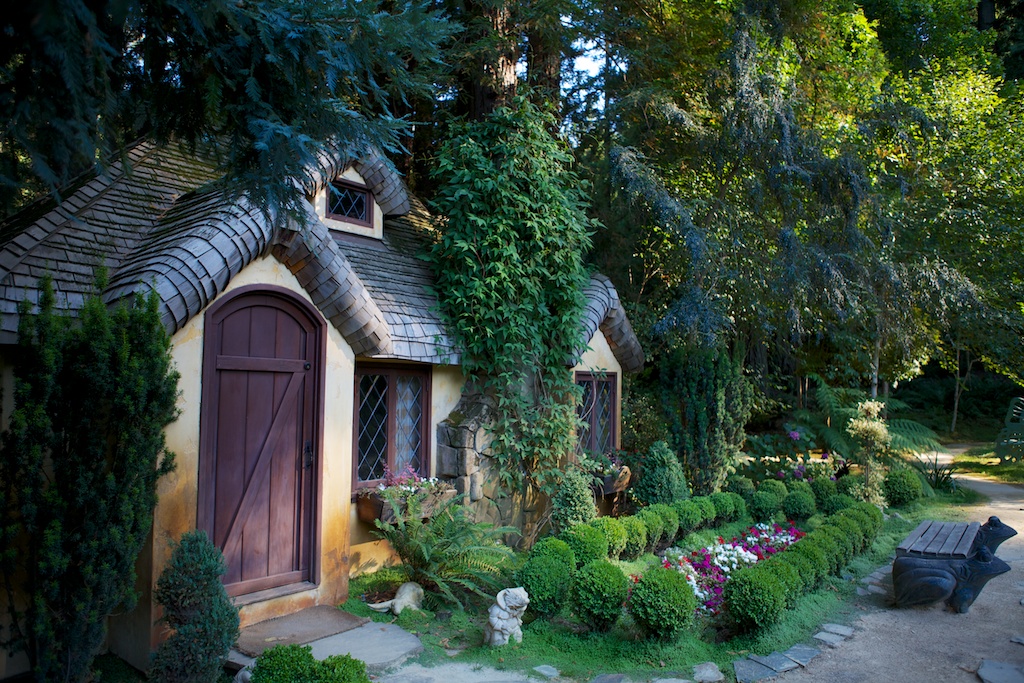
… and a train!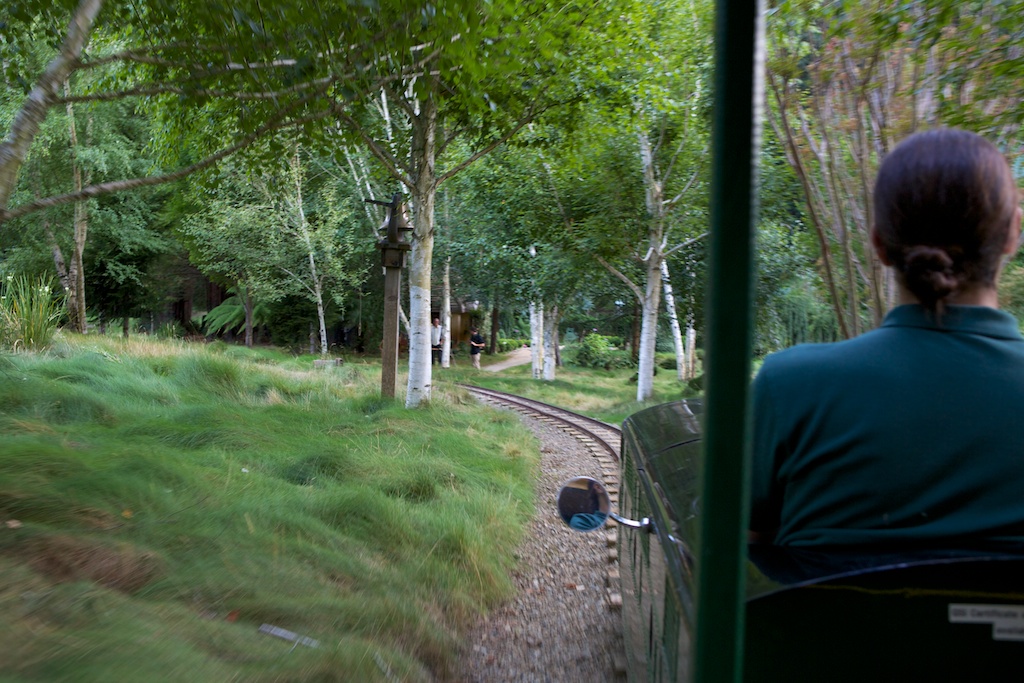
Saxophonist Timothy McAllister took a video of our train ride.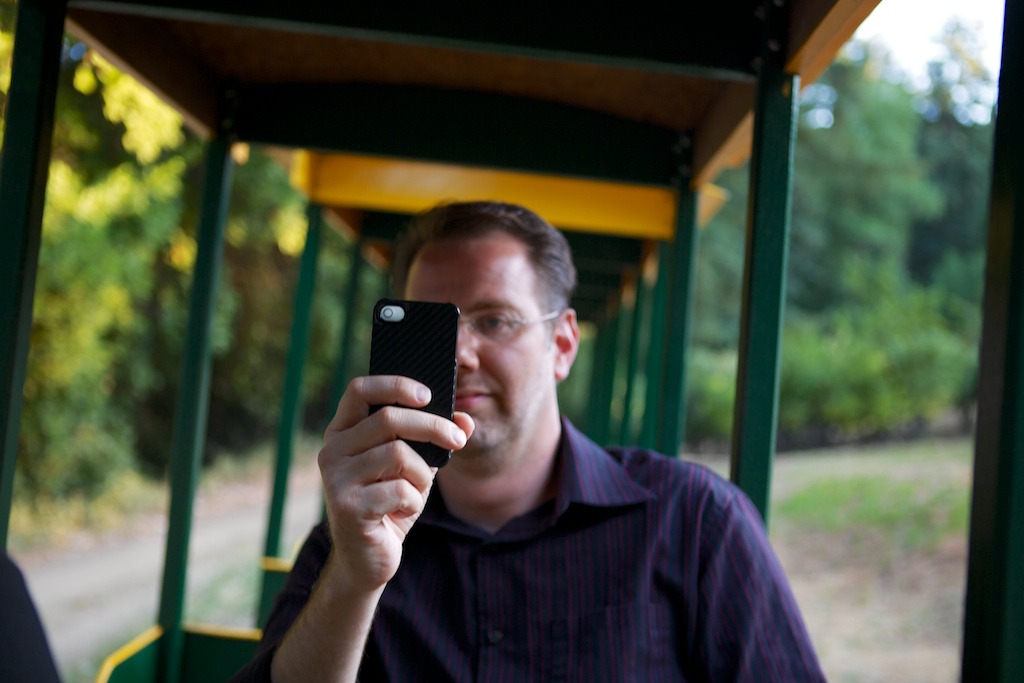
Joseph Alessi takes a photo to document the poor treatment of a trombone. His own trombone, which he left in the grass at some point during the party, a habit I can only assume he developed during high school marching band.
The event ended with a chamber music concert, and that concert ended with a performance of “Breakdown Tango” (performed by members of the festival orchestra).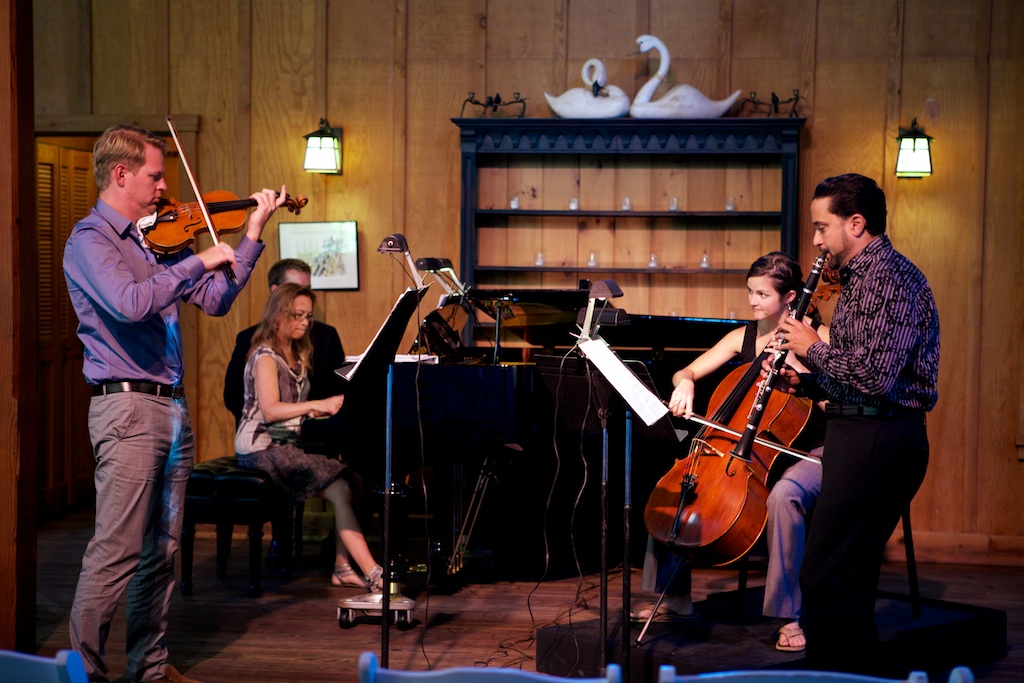
The next day: sightseeing! This photo, from my last visit to the festival, was hanging in the local bank. (I think I look better with bangs.)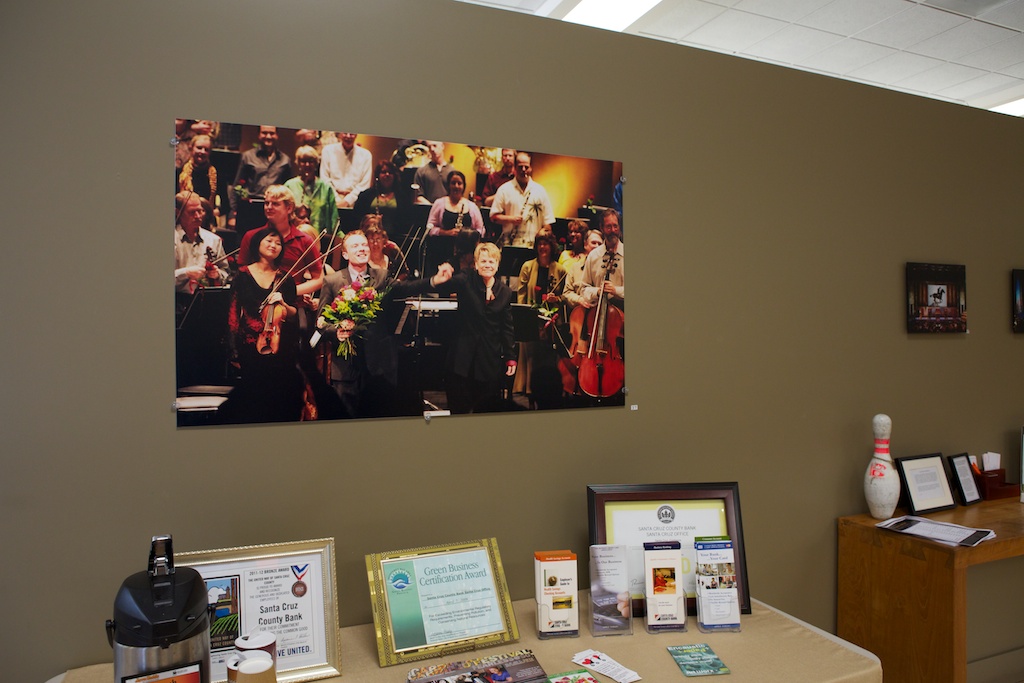
We went for a hike in the Henry Cowell State Park. The trees there are large. (This may be the only photograph in existence of me in sneakers.)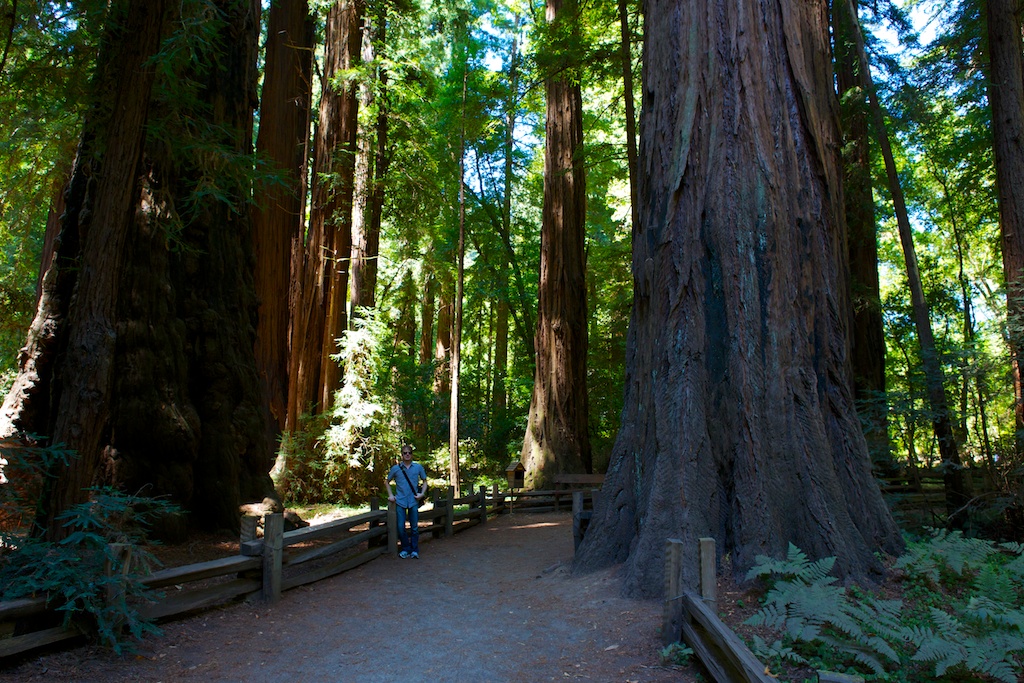
Santa Cruz has a thing for musical saws.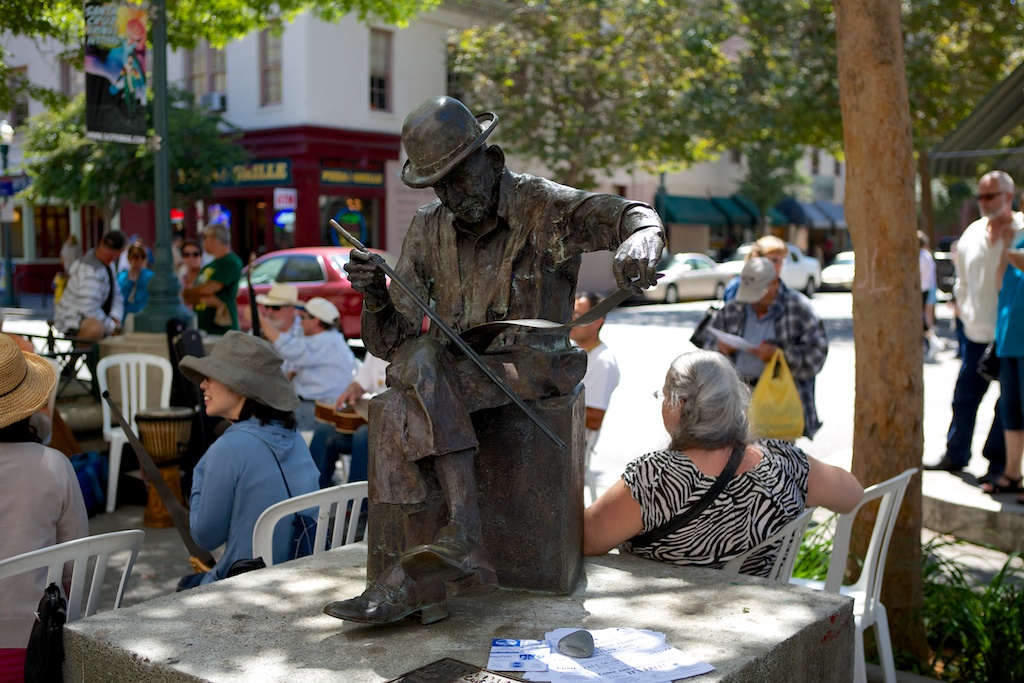
Did you think I was making that up?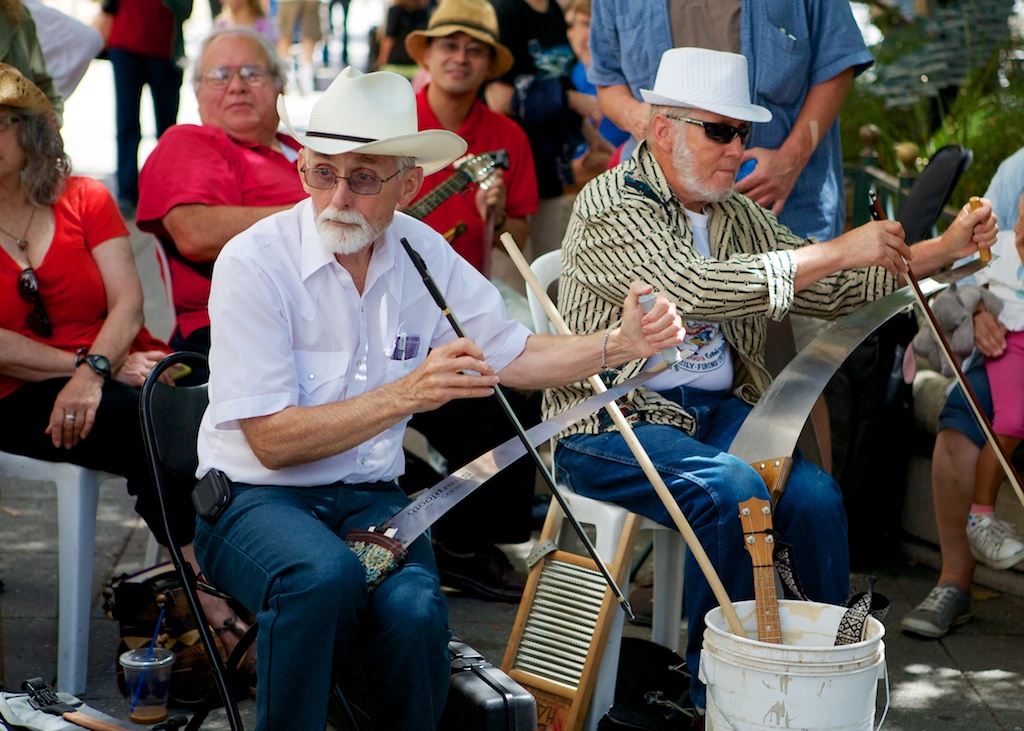
The hall before Saturday night’s concert, featuring the music of Andrew Norman, Osvaldo Golijov, Dylan Mattingly (a very talented and very young composer), and Lou Harrison.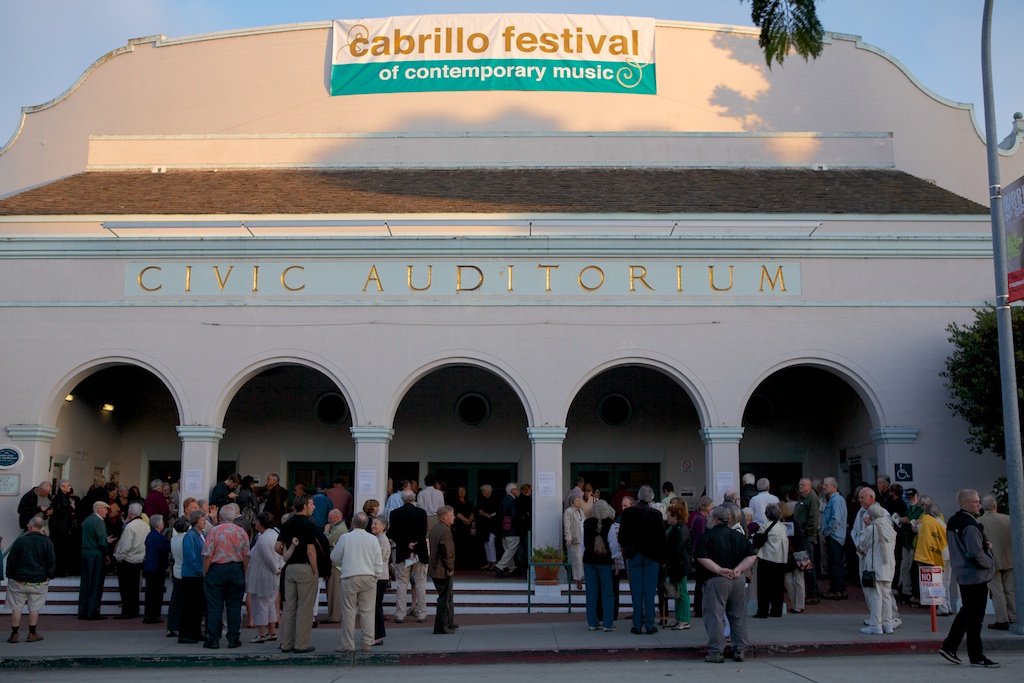
Look who was in the audience! My composer hero, John Adams!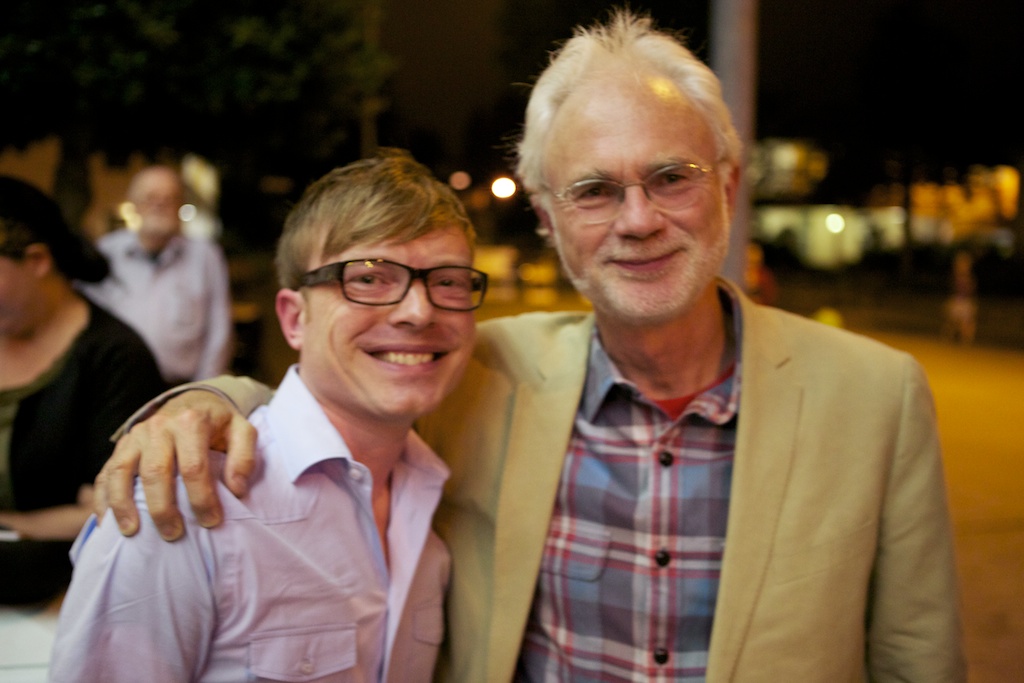
After the concert, a cake-and-champagne reception. The cake had the composers’ pictures on it. Here, Andrew Norman takes a picture of the picture of his face on a cake.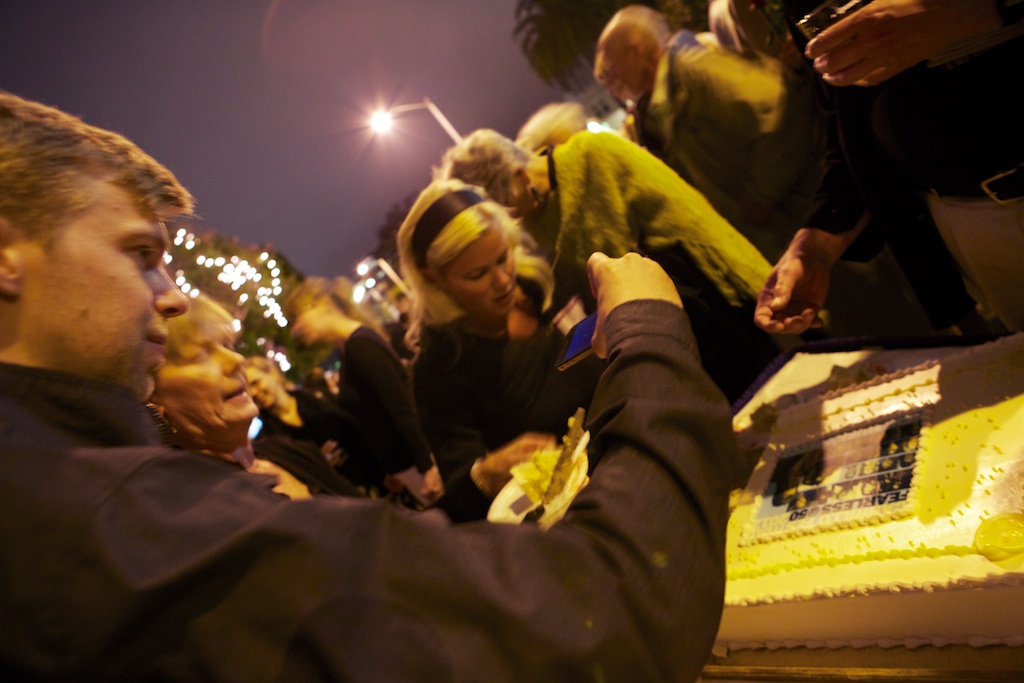
I clearly did the same thing.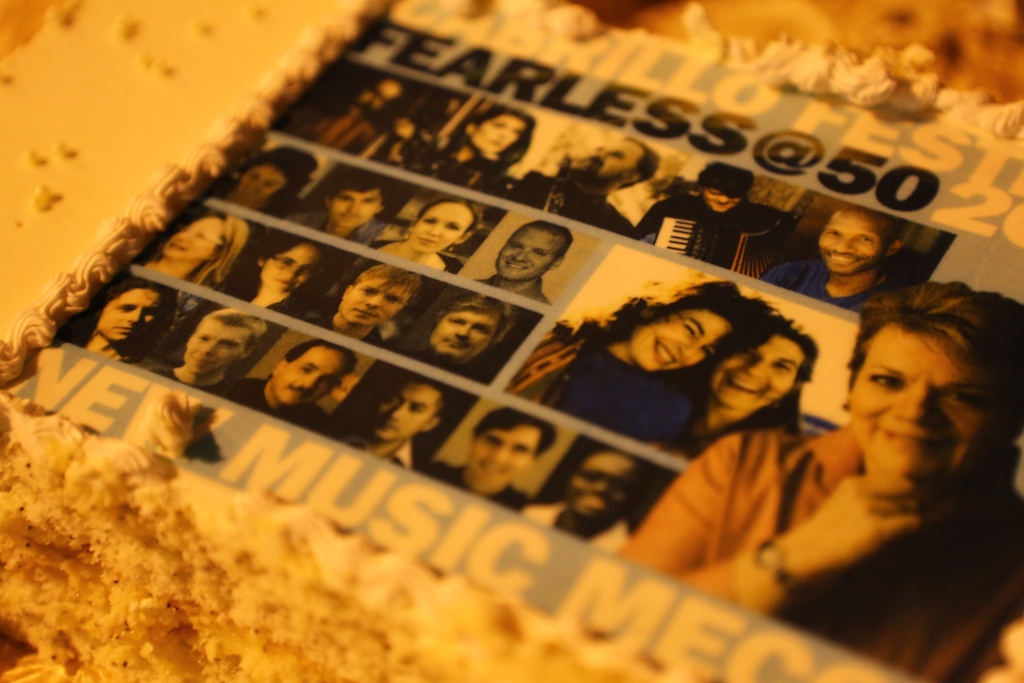
My performances were the next day at the Mission San Juan Bautista, a Spanish mission originally founded in 1797.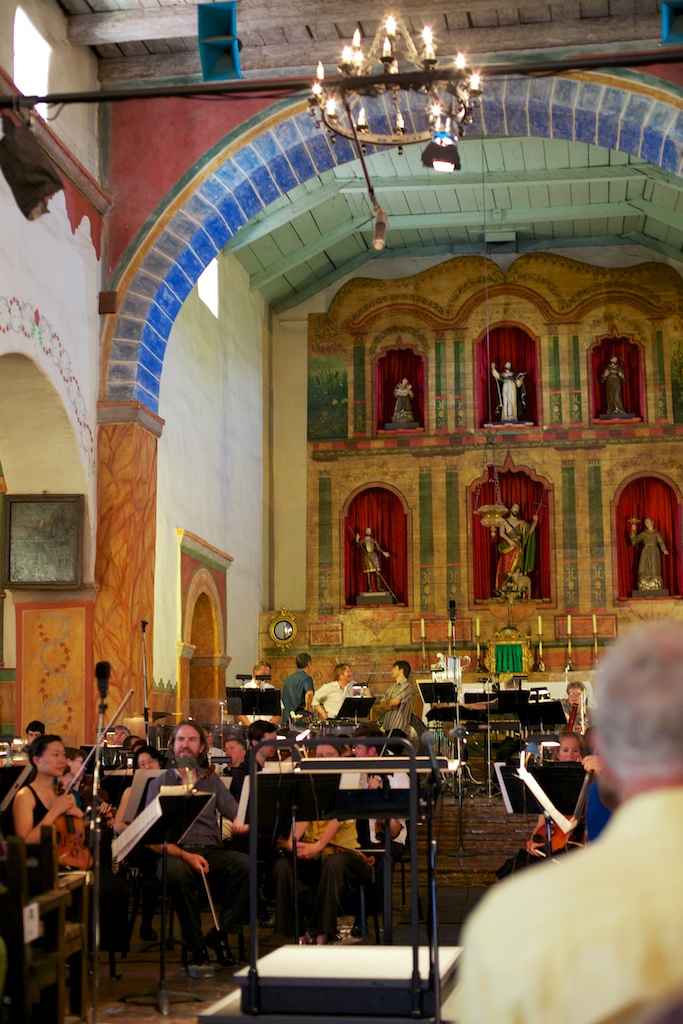
Two performances of a trombone concerto on the same day?! Only Joe Alessi could pull off such a thing. The first concert was great — and even more impressive when you realize that there was absolutely no sound check in the hall (and the rehearsals had all been in the auditorium in Santa Cruz).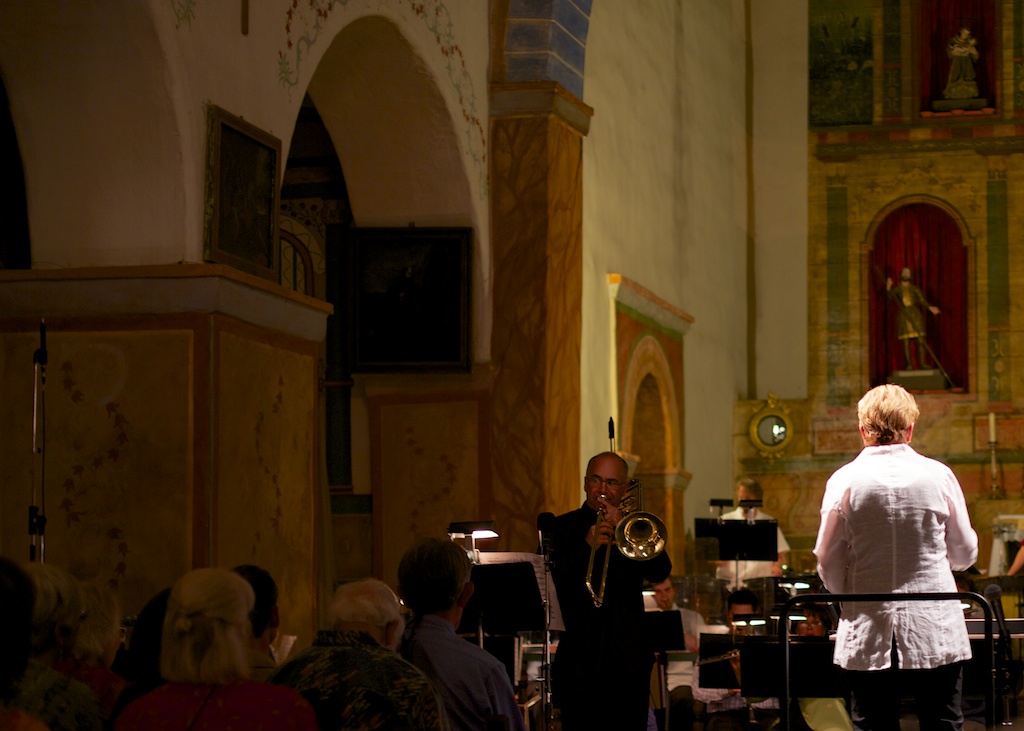
The second concert, though…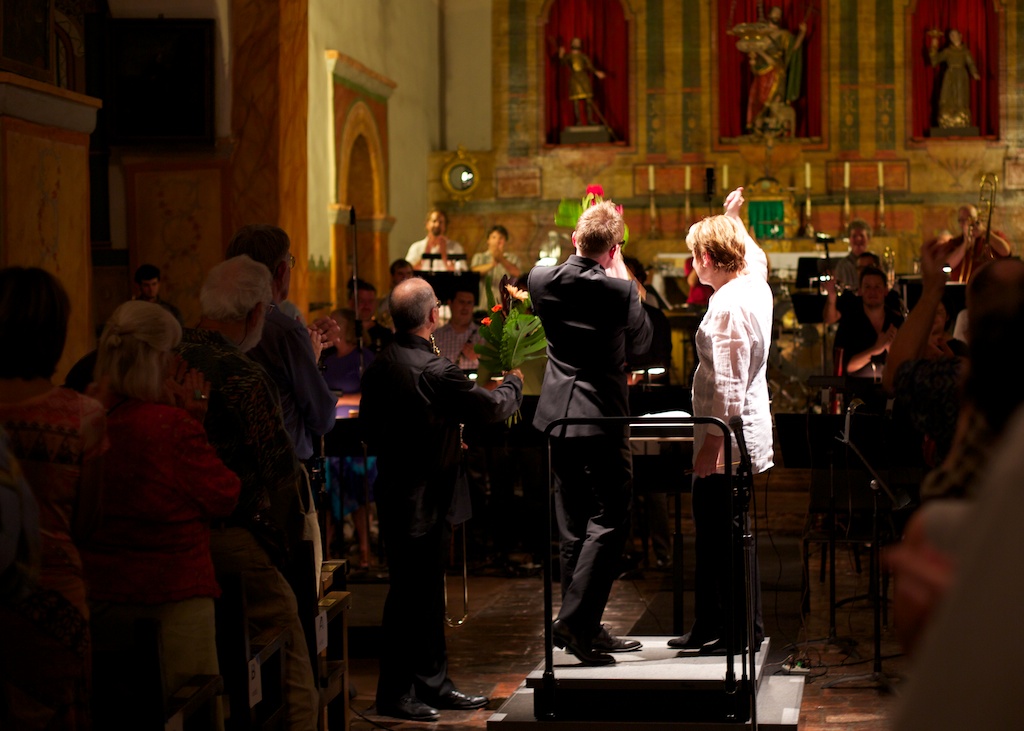
… was among the best performances I’ve ever had.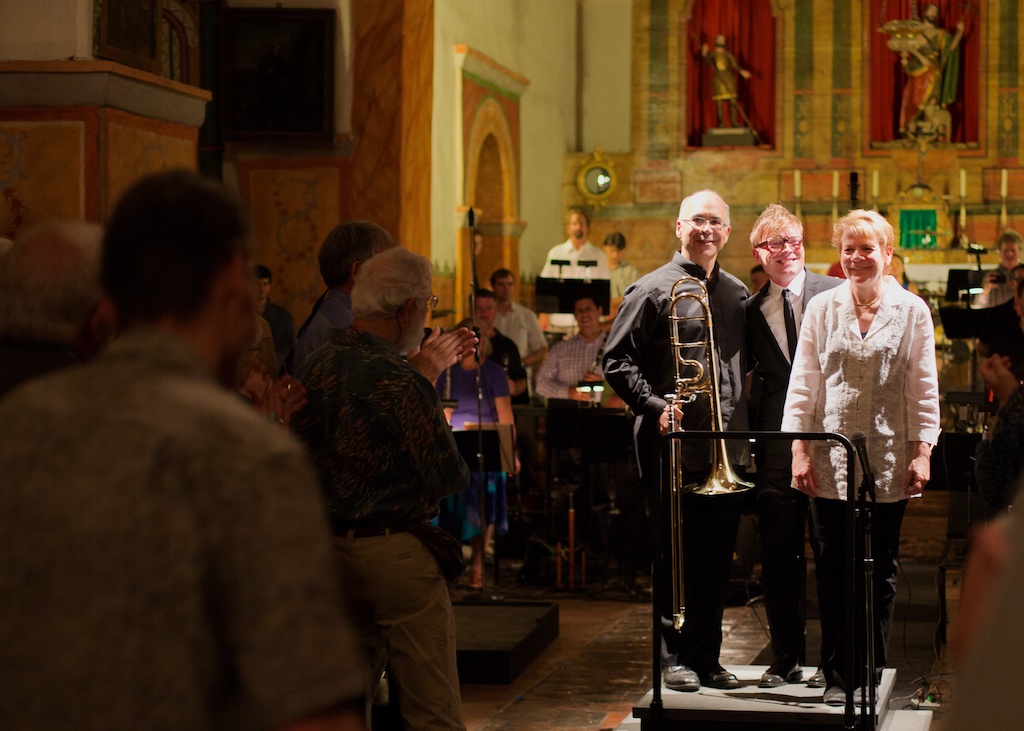
We all needed a celebratory drink after the concert. Alessi needed four.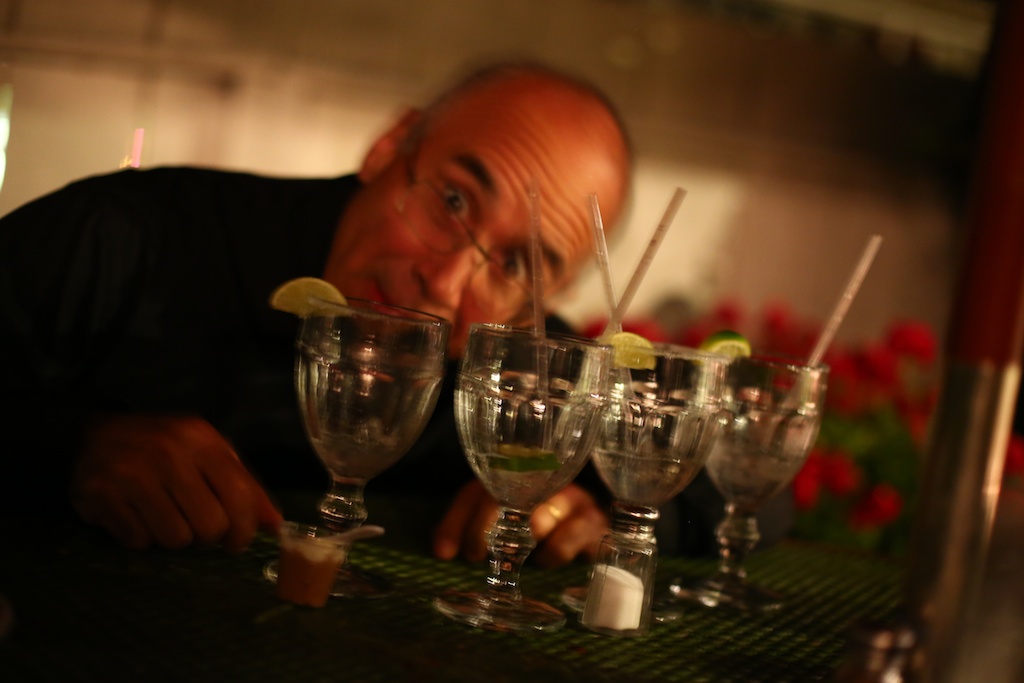
It’s crazy (and crazy-humbling) that the last piece on the final concert of the Cabrillo Festival’s 50th Anniversary season was “Harvest.” It’s all the more amazing when one realizes that they ended the entire festival with… well, it’s really a band piece, commissioned by military, university, and high school bands from all over the US. (Yay, band!) I want to go back to Cabrillo whenever they’ll have me, and next time around, I’ll try to have something for the strings to do, too.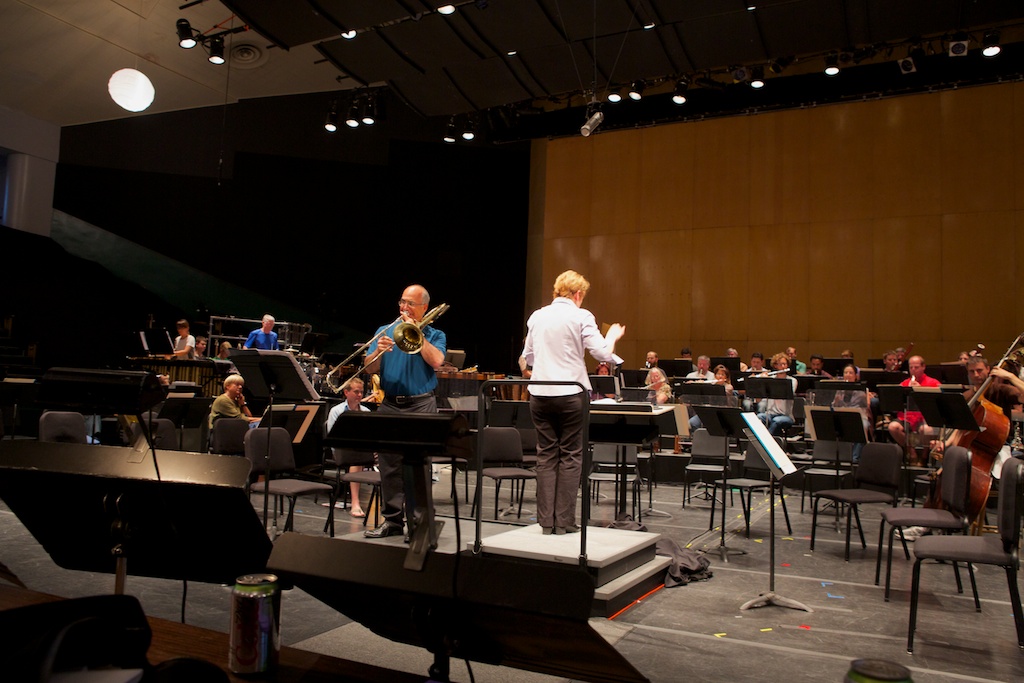
It was a perfect week. Thank you, Marin, for programming my piece, and doing it so brilliantly. And I can’t say enough about the wonderful players in the orchestra, who nailed the piece on the first reading, and nearly blew the walls down at the performances. (One audience member who had been sitting in the second row for the performance approached me after the concert to congratulate me. “Was it too loud?” I asked. “No, it was great! My wife even had to take out her hearing aids.”) And of course the piece wouldn’t even exist without Joe Alessi, God of Trombone.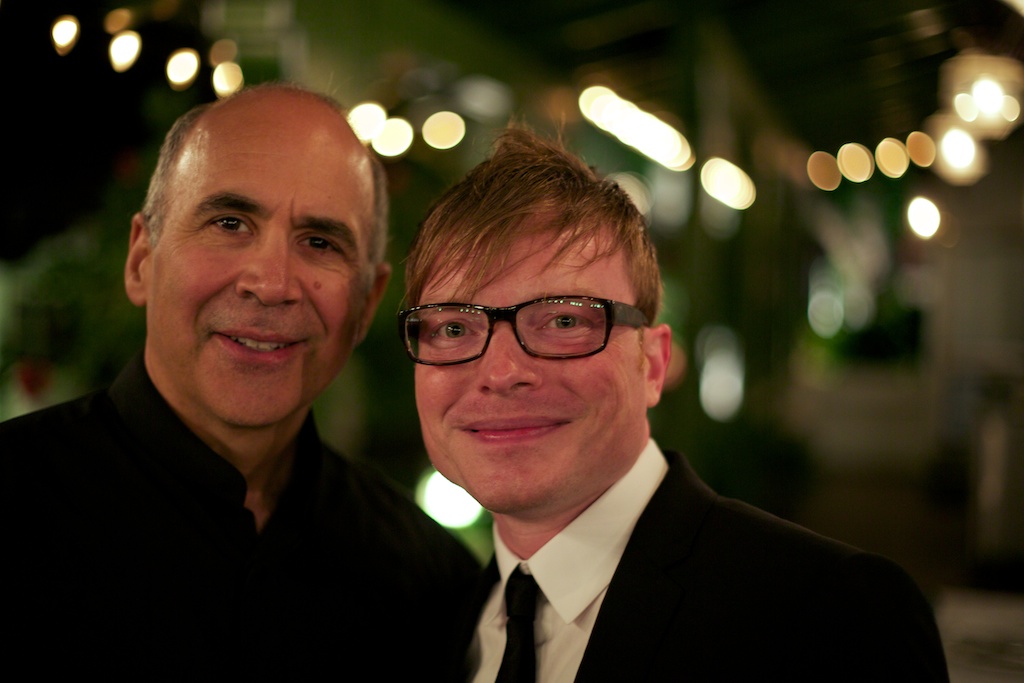
May 31, 2012
Trombone Choir
After literally years of trying to make it happen, I’ve been commissioned to write a piece for trombone choir. This will hopefully be the first of two pieces over the next few years. This first one will be an adaptation of “Hymn to a Blue Hour,” scored for solo tenor trombone with trombone ensemble. The premiere will be in March 2013 at the Eastern Trombone Workshop, performed by Joseph Alessi and the Washington Trombone Ensemble.
View Comments
Comments
I went to the jr prom with your father. Although he said you were an excellent trombonist, I never knew you also composed. He is so proud of you. Congrats on your talent. Must have gotten it from him!
Add comment
May 30, 2012
High Wire – premiere and recording
In February 2011, Scott Corley, the Music Director of the University of Wisconsin-Milwaukee Youth Wind Ensemble, contacted me to ask if I would write a concert opener for his group. It would be in honor of Thomas Dvorak, who had founded the ensemble thirty years earlier. My only other “opener” at that point was “Asphalt Cocktail,” and it’s more of a closer, so I thought, Sure! Let’s write something flashy and cheery and short (and no, the piece is not autobiographical).
The UW-Milwaukee Youth Wind Ensemble consists of high school-aged players who rehearse once a week. Scott asked for something around a “grade 4+” and I thought, Sure! I can do that.
The timing was a little screwy, though. The piece was initially due on February 1, but right before that, I wrote my slow “grade 3” piece, “Sheltering Sky.” That piece was a bitch-and-a-half to write (writing easy music that doesn’t sound “simple” : hard. Writing easy SLOW music that doesn’t sound simple and cheesy: nearly impossible, at least for me), and completing it took a lot longer than I’d planned. I finished “Sheltering Sky” on January 20. Finishing another piece by February 1 was not going to happen.
Scott agreed to give me until March 1 to finish his piece (but I hadn’t left him much choice). Even with a timeframe like that, I knew there could be trouble. I usually allow at least several weeks between pieces, because I need time to clear the previous piece out of my head. I think that any piece is kind of the “cousin” of the piece that follows it. You can’t help but have a little of that sound stuck in your head when you start the next piece. But without sufficient time between pieces, a “cousin” becomes a “brother,” and that can be bad (and I think is only legal in Mississippi).
I wrote the first draft material for Scott’s piece on January 24 – probably the day after I finished the parts for “Sheltering Sky.” Instead of falling into the trap of writing a close variation of the previous piece, though, I went completely in the opposite direction. After spending six weeks writing slow music in Eb Major with only the occasional use of a single accidental, my brain was feeling really, really antsy. And I couldn’t write in Eb Major.
So I wrote mostly in an octatonic scale (a synthetic scale consisting of alternating whole-steps and half-steps, for example: C, Db, Eb, E-natural, F#, G, A, Bb — resulting in 8 notes in an octave, rather than the 7 you’d get in a major or minor scale), and I filled the harmony with polychords (commonly used by Stravinsky and many other composers, it’s a combination of chords from different keys at the same time, like a D Major chord and an Ab Major chord at the same time — the opening gesture of “High Wire“).
And I made it really fast. Lots of octatonic scales, which aren’t normally practiced by high school players, played in 16th-notes at quarter note=164. The euphonium part goes up to high C. The trumpets: also high C. The percussion parts play in multiple meters simultaneously (although it’s all barred together). Then there are the balance problems. How do you make it so you can hear all of those difficult woodwind runs while the brass is playing sustained polychords? And how do you get polychords effectively in tune?
In other words, it’s not a “Grade 4,” and it’s not a high school piece. I completely overshot what I was asked to write, but you’d have never guessed that from the performance. The rehearsals and been pretty good, but a little scary. I mean, the group only meets once a week! The concert, though: hot. Scott Corley exploded with energy from bar 1, and the students were right there with him. It was a great premiere. (This is the plaque that the ensemble presented to Thomas Dvorak at the concert.)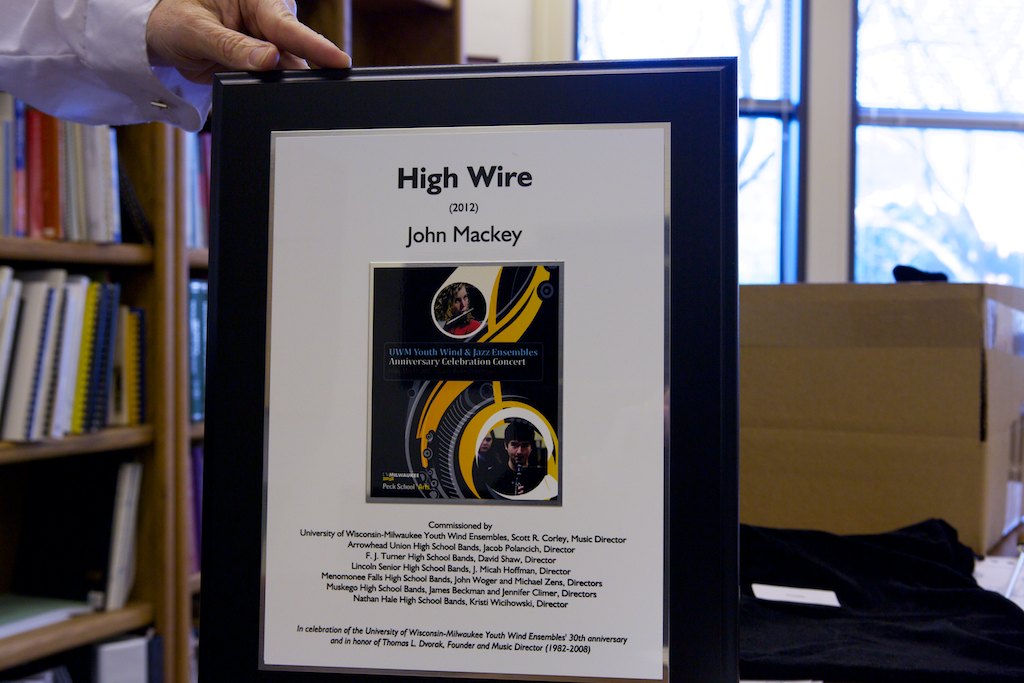
Also, Milwaukee: surprisingly hip and picturesque.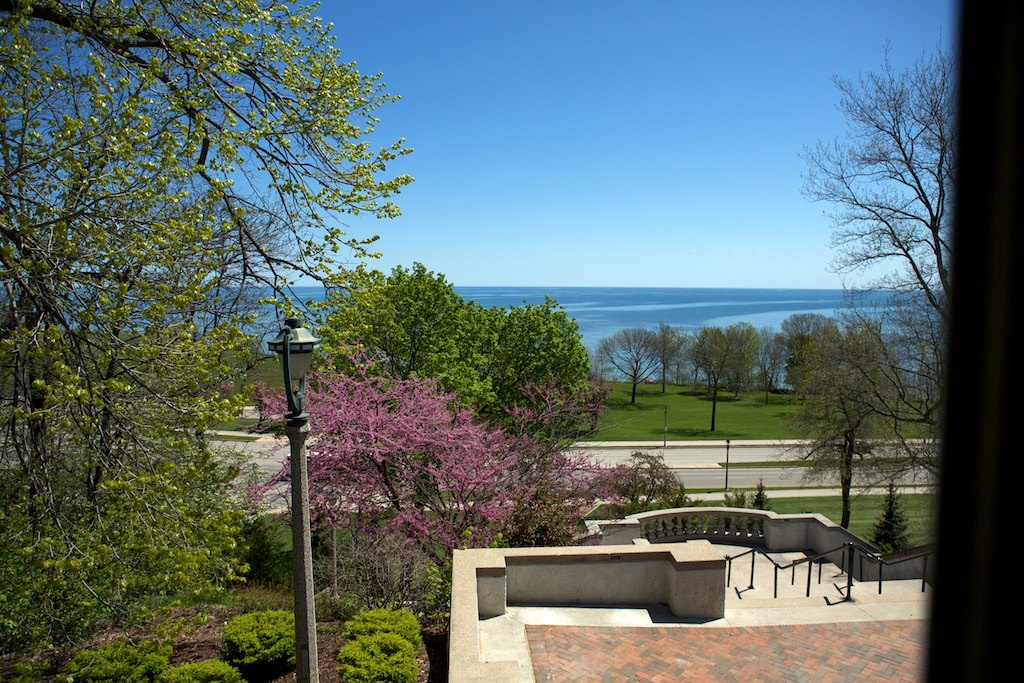
The other band from the Youth Wind Ensembles performed “Foundry.” It’s always fun to see what people come up with for the “4 metal piles”…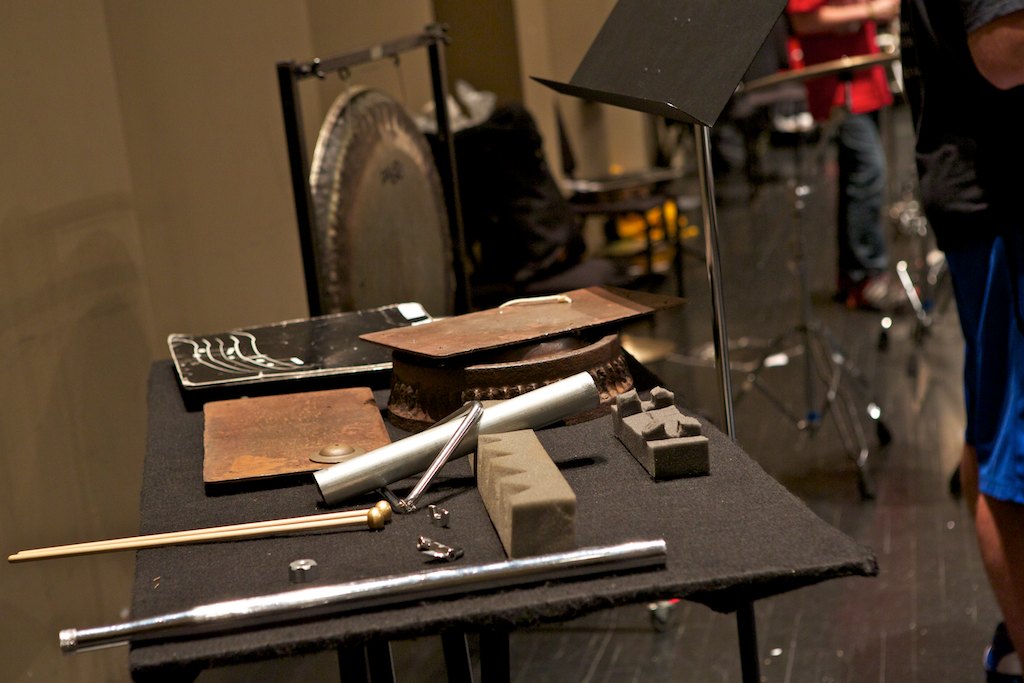
… and especially for the “clang.” This was the biggest “clang” I’d ever seen. It took two people to carry it.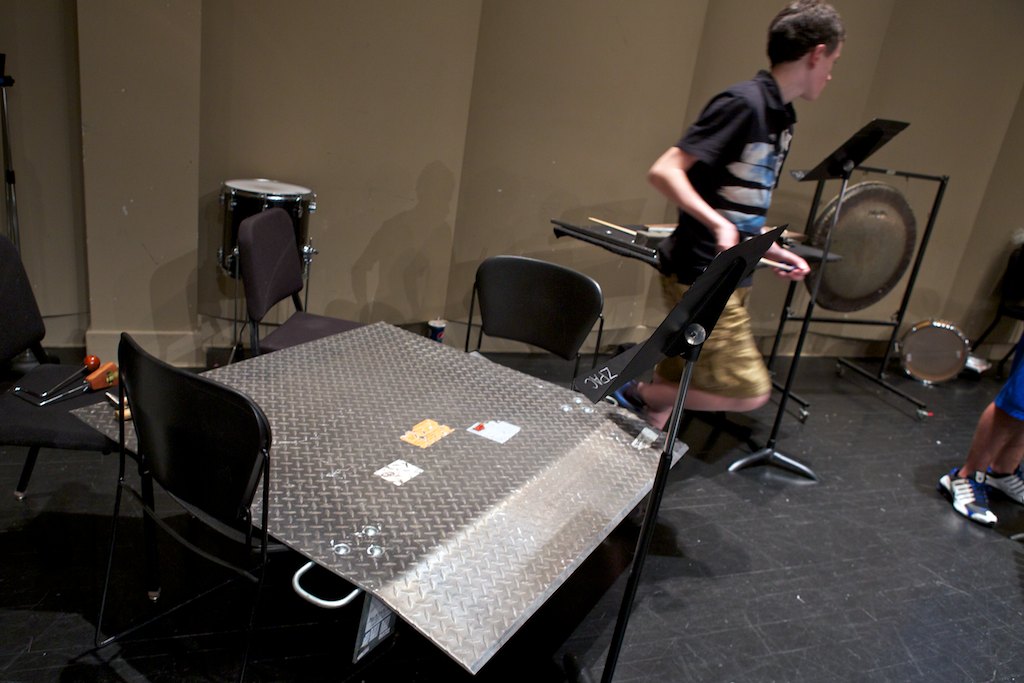
It sounded great.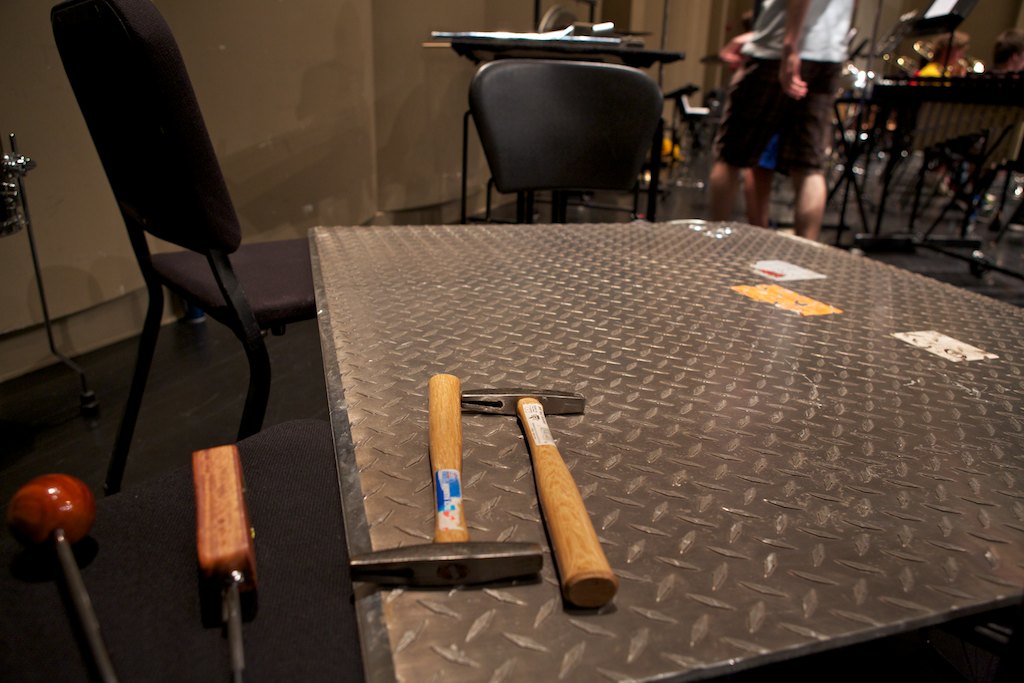
During my visit, I tried a Zevia cola — a non-sugar soda, sweetened with something natural called “stevia.” I wouldn’t call it “yummy.”
Thank you to Scott Corley and the University of Wisconsin-Milwaukee Youth Wind Ensembles for commissioning “High Wire” — and for working so hard to make the piece sound so good.
You can hear a recording of the piece, as graciously recorded by my friends Richard Clary and the Florida State University Wind Orchestra, by visiting the “High Wire” page. The score is there, too, if you’d like to read along.
Or if you’re super lazy, you can just click below.
[ca_audio url=”https://www.johnmackey.com/audio/HighWire.mp3″ width=”500″ height=”27″ css_class=”codeart-google-mp3-player”]
View Comments
Comments
Classy piece. I like it.
The piece was SO fun to play, thanks so much for writing it!
Cool. Now I have to rethink my programs for the upcoming year so we can play this!
Mr. Mackey, I'm a student at Penn High School, and when we got this piece out and performed it, I was stunned at the vigor of it. Then my instructor, Mr. Paulson told me the story of how this came to be, and I had to laugh. See, I'm a composer myself, and I recognized the octatonic scales and polychords immediately. Probably my favorite parts of it is when you'll have G-major then Eb-major in the low brass, making some Ebma7(b13) chord.
I've looked into many other of your pieces, and I think besides maybe Penderecki or Trent Reznor (I have a deep respect for his music), you're one of my favorite modern composers.
Fantastic job on High Wire, and I hope you get stuck with many more Grade-3, Eb-major chorales to write, so masterpieces like this can come along.
View Comments
Comments
Sarah Sielbeck says
Okay, this was good and with the right amount of humor (loved the marching band comment), but I'm waiting for your food blog post! Chop, chop, get with it! ;<)
Richard Clary says
Wait! Is this trick photography, or are you really TALLER than Marin Alsop? That aside... what a huge triumph! "Congratulations" seems inadequate -- on both counts.
Add comment